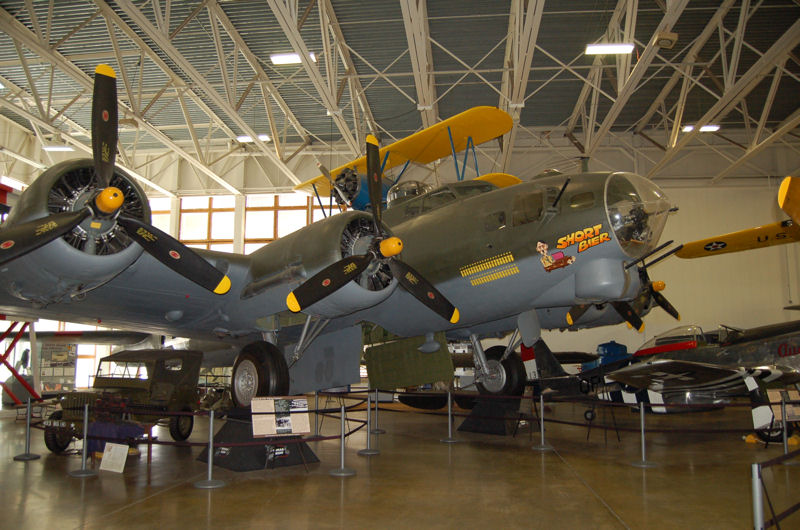|
Boeing B-17G-90-DL (44-83663) "Short Bier" Flying Fortress

Any questions, comments, or problems, please email
me.

From the Hill Air Force Base Fact Sheet Crew: Ten
Engines: Four Wright Cyclone R-1820-97 radial; 1,200 hp each
Wingspan: 103 ft 9 3/8 in
Length: 74 ft 4 in
Height: 19 ft 3 in
Weight: empty: 36,135 lbs; maximum: 72,000 lbs
Speed: cruise: 182 mph; maximum: 287 mph
Range: normal: 2,000 miles; max: 3,750 miles
Service Ceiling: 35,600 ft
Armament: 13 .50 caliber machine guns; up to 17,600 lbs of bombs in internal bomb bay and external racks; normal bomb load: 4,000 lbs
Cost: $204,370 (average B-17 unit cost in 1944) |
This B-17G, S/N 44-83663 "Short Bier," was manufactured by Douglas Aircraft in Long Beach, California, and delivered to the USAAF on May 1, 1945. The following month it was transferred to Patterson Field, Ohio, and later that year was transferred to the 4132nd Base Unit (Air Materiel Command) in Garden City, Kansas.
It was then transferred to the 4141st Base Unit (AMC) at Pyote Field, Texas, in December of 1946 and finally placed in storage there with the 2753rd Aircraft Storage Squadron in April 1950. In March 1951 the aircraft was transferred to Spartan Aircraft Corporation in Tulsa, Oklahoma, for maintenance, and in June 1953 was turned over to the Brazilian Air Force. For the next 15 years the plane was operated in South America.
The aircraft was returned to the U.S. Air Force at Wright-Patterson AFB, Ohio, in June 1968 and in early 1973 was loaned to Yesterday's Air Force in Chino, California. In 1978 it was loaned to the Warbird Museum in Topeka, Kansas. From there it made its last flight under its own power to a museum at the U.S. Coast Guard Air Station in Clearwater, Florida. Attempts were made to keep the old plane in flying condition, but a lack of funds forced that museum to close its doors and the aircraft was then temporarily assigned to a museum in Cleveland, Ohio.
In the spring of 1987 the plane was acquired by Ogden businessman John A. Lindquist, a member of the Board of Directors of the Aerospace Heritage Foundation of Utah, for restoration and display at Hill Aerospace Museum. Even though the engines were still being "run up" periodically the aircraft had deteriorated to being non-airworthy. The aircraft was dismantled by a crew from Hill AFB and transported back to the base via C-5 Galaxy. The B-17 was moved to the museum grounds and there reassembled for restoration. Exterior restoration was completed in the spring of 1991 and museum volunteers are still working on the renovation of the aircraft's interior.
Since its acquisition the B-17 has been sponsored annually by Mr. Lindquist, who flew as navigator on the original "Short Bier" in the 493rd Bombardment Group (Heavy) of the Eighth Air Force during World War II. The 493rd started out flying B-24s, but later switched over to B-17s. The first "Short Bier" was a B-24 Liberator, but when the squadron switched to B-17s the name was transferred to one of the Flying Fortresses. Lindquist and his crew finished their tour of duty in the B-17 "Short Bier," but that aircraft was later lost in action. Our restored B-17 is therefore the third "Short Bier" and is painted in the colors of the 493rd Bomb Group.
|